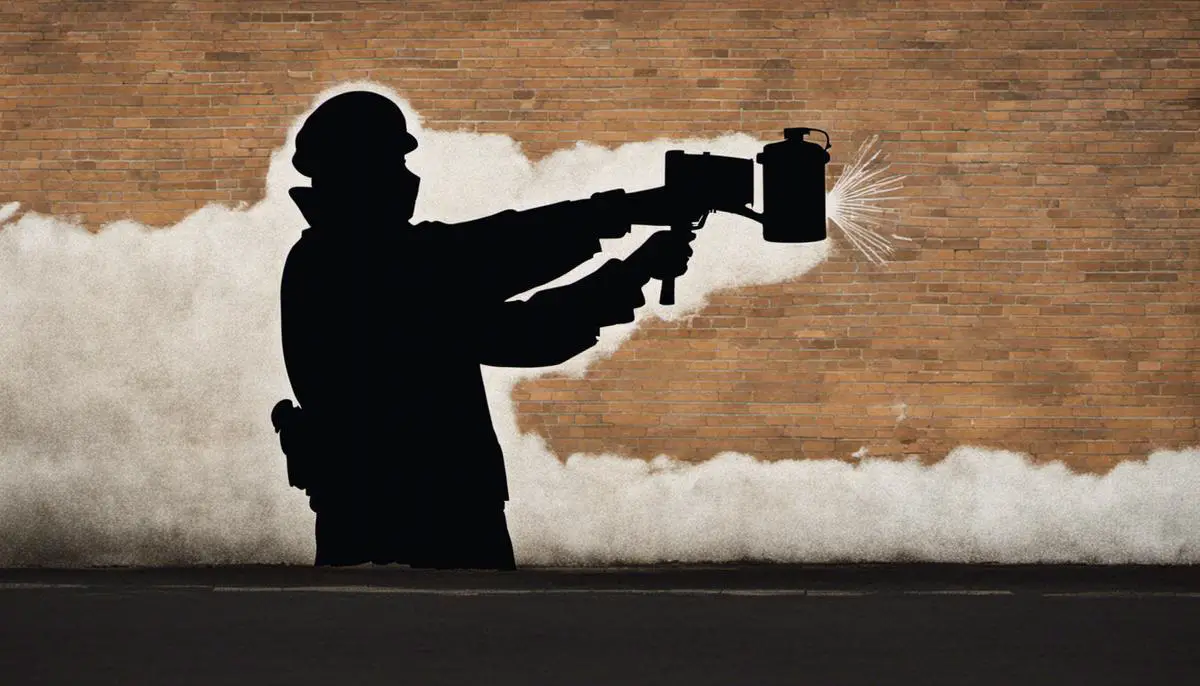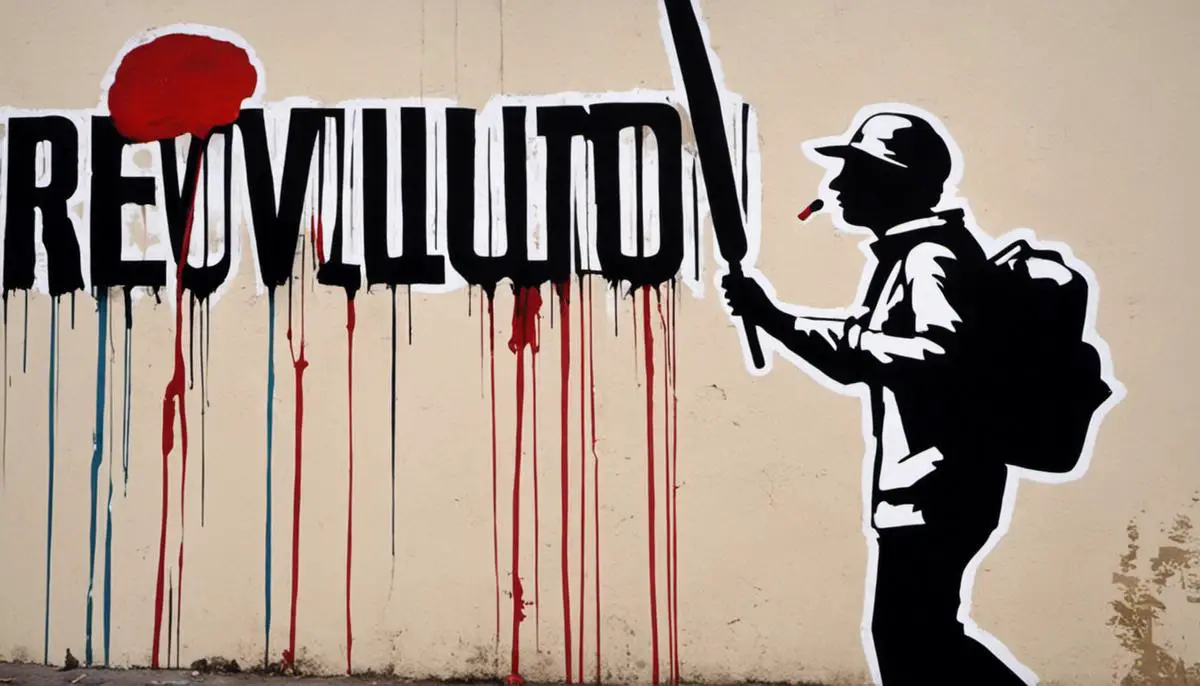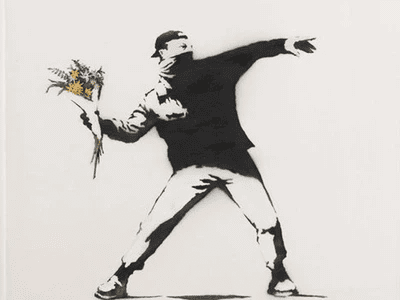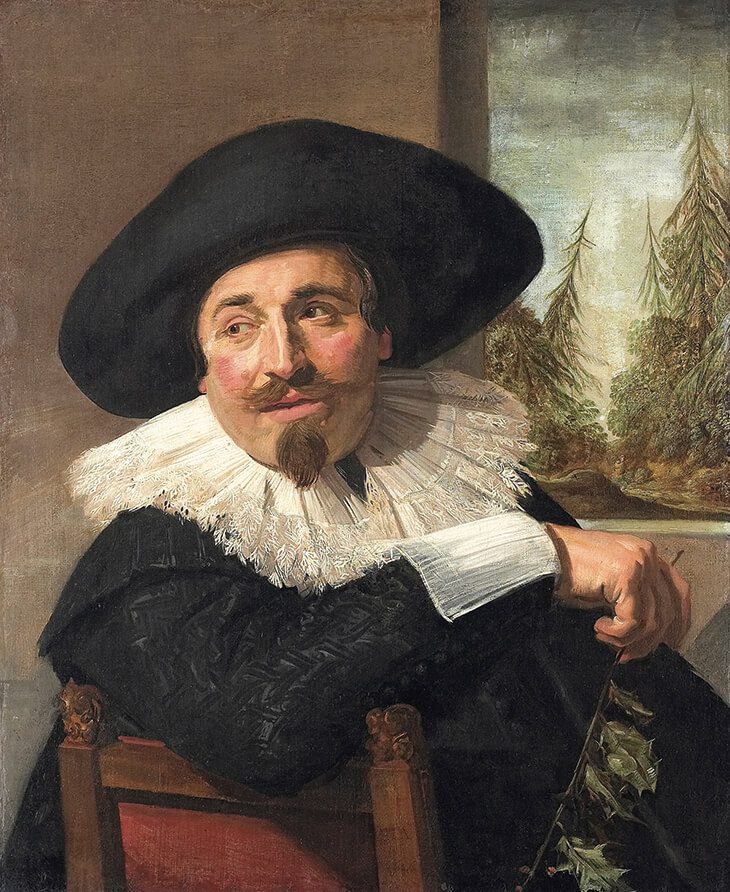Exploring the Enigmatic World of Banksy’s Street Art

In the world of street art, few figures loom as large or carry as much mystique as the elusive Banksy. Emerging from nowhere, this shadowy figure has carved an indelible mark on urban landscapes across the globe. With a signature style that marries biting satire with refined stencilling technique, Banksy’s works are instantly recognisable and provocatively thought-provoking, punctuating the mundane with poignant commentary on social and political milieu. Immersing ourselves deeper into this enigmatic persona’s world, we aim to unravel the enigma of Banksy, tracing his ascension, exploring his iconic works, and evaluating his enduring legacy.
Banksy: A Mysterious Figure
The Enigma of Banksy
Mystery shrouds the identity of Banksy, the world-renowned but elusive street artist. Despite continuous speculations attempting to unveil his persona, the artist skillfully remains incognito, maintaining his anonymity. Over the years, wild guesses and countless investigative pieces have proposed figures like Robert Del Naja, a member of the massive attack, or Robin Gunningham, an otherwise nondescript individual from Bristol as Banksy. Yet, none of these allegations could be substantiated with definitive proof.
Origins and Presumptions
Born into anonymity, Banksy’s origins are as elusive as his identity. He is generally presumed to hail from Bristol, England, given that his earliest work cropped up in this city during the 1990s. His works reflect an apparent familiarity with the city’s cultural and social scenes, reinforcing speculations of his Bristolian roots. In true Banksy style, the artist himself offers no clarifications, adding another layer to the mystery surrounding him.
Emergence in the Street Art Scene
Banksy’s emergence within the street art scene was marked by his distinct style, characterised by his stencilling technique that lent his work both speed and anonymity – two critical requirements in an underground subculture often subject to legal ramifications. His ability to present social and political commentary through his works catapulted him into the limelight. While his identity remained camouflaged, his art took on a life of its own, leading to global recognition.
Rise to Prominence
Banksy’s rise to worldwide prominence wasn’t overnight. His early works in Bristol and London were largely unnoticed until reproductions started bouncing around the internet. Recognised for their poignant messages, they began to gain public favour. His 2005 stencil work highlighting the living conditions in the Bethlehem area played a significant role in his international emergence, making Banksy a household name in the world of street art. His controversial pieces often encase social discourse and political satire under a veneer of dark humour and suspense, making his work intriguing and simultaneously, impactful.
Banksy’s Art as a Reflection of Himself
Although Banksy’s street art enjoys wide-spread recognition and his name is synonymous with a distinctive graffiti style, the man himself remains enigmatically elusive. Banksy consciously lets his art speak for his identity, using it as a platform for raising awareness on pressing societal issues. His choice to remain behind the scenes ensures that the spotlight falls on his work rather than his persona, reinforcing the notion that art can exist and speak for itself separate from its creator. This approach has resulted in Banksy’s ?work continuing to fascinate audiences worldwide while the artist deftly stays out of the limelight.

Banksy’s Signature Style and Themes
The Signature Use of Stencilling in Banksy’s Art
One of the standout techniques in Banksy’s art is his use of stencilling. Born out of Bristol’s underground art scene, this method allows Banksy to conceal his identity while working fast, and at the same time, producing intricate, finely detailed designs.
His stencils are typically multi-layered, bringing remarkable depth and complexity to his creations.
From simple monochrome sketches to elaborate, colourful pieces, each stencil bears Banksy’s indelible mark, branding it unmistakably as his own.
Banksy’s works are often centred around a number of recurring themes.
At the heart of many of his pieces is a powerful, satirical critique of capitalism, war, and authority.
Whether he’s depicting a bouquet of flowers in a riot policeman’s hand or a young girl frisking a soldier, Banksy’s images are designed to make us question the world around us.
His pieces are known for their subversive humour and poignant commentary, prompting viewers to think more deeply about the subjects they depict.
Alongside his critiques of social and political issues, Banksy’s art often explores themes of hope, freedom, and innocence.
Many of his most notable pieces feature children, animals, and other sympathetic figures, their vulnerability offering a stark contrast to the harsh realities that surround them.
These images not only elicit an emotional reaction, but also challenge our assumptions and perspectives about societal norms and values.
Another major aspect of Banksy’s work is his commitment to using public spaces as his canvas.
For Banksy, art is for the people, not merely the privileged few who can afford to visit galleries or purchase paintings.
As such, his pieces can be found in the most unexpected of places – on the sides of buildings, on street corners, and sometimes even on objects within the public domain.
This defiance of traditional venues helps to make his work accessible to all, while also enhancing the surprise and intrigue that are integral to street art culture.
Within Banksy’s work, the use of satire is particularly prominent.
The artist frequently employs irony and juxtaposition to convey his message, distorting familiar images or themes to highlight their inherent absurdity or injustice.
From a young girl happily skipping under the flight path of a drone, to a monkey wearing a sandwich board proclaiming ‘Laugh Now, But One Day We’ll Be in Charge’, Banksy’s use of satire is both biting and thought-provoking.
Banksy’s street art is revered worldwide not only for its distinct visual style but also for its ability to question convention and stimulate thoughtful dialogue. These qualities have firmly established this enigmatic artist amongst the most illustrious and contentious figures in the realm of contemporary art.

Most Notable Works and Their Locations
Girl With Balloon
One of Banksy’s most striking pieces, “Girl with Balloon”, portrays a young girl stretching out for a heart-shaped balloon. First painted on a South Bank wall in London during 2002, the artwork’s simplistic design has widely been interpreted as a representation of hope and loss. The innovative yet heartwarming tone of the artwork, combined with its dramatic shredding at a live Sotheby’s auction in 2018, has only amplified its fame amongst the general public and the art fraternity.
Rage, Flower Thrower
A landmark piece of Banksy’s politically charged portfolio, “Rage, Flower Thrower” was created in Jerusalem in 2005. It depicts a masked protester mid-throw, but rather than a Molotov cocktail or rock, he is throwing a bouquet of flowers. This juxtaposition plays on the theme of peace versus violence and offers commentary on the Palestinian-Israeli conflict. The location and theme of this piece provoked significant discussion and analysis upon its release.
Kissing Coppers
In 2004, Banksy took to a pub wall in Brighton to create “Kissing Coppers”, a black and white stencil piece showing two male British police officers in a passionate kiss. Just like many of his other works, Banksy uses irony and humour to push boundaries and provoke thought around societal norms and institutional structures, in this case, the police force and homosexuality. The piece was eventually removed and sold to a US collector, illustrating the transient nature of street art.
There Is Always Hope
Again delving into the theme of despair and optimism, Banksy’s “There Is Always Hope” mural can be found on a wall in London. It shows a girl watching as a heart-shaped balloon floats away from her. This piece resonates with viewers because of its poignant message and the way it captures the universality of lost love and missed opportunities. It’s also an example of how Banksy’s work can be subtly disruptive, appearing unannounced and unsanctioned, often leading to controversy and vibrant dialogue about the nature and value of street art.
Sweeping it Under the Carpet
Located beneath a London bridge, “Sweeping it Under the Carpet” depicts a maid lifting a corner of a brick pathway to sweep dirt underneath. This artwork could be interpreted as a commentary on social class and the denial of societal issues. As with many of Banksy’s works, the piece makes use of actual physical objects in the environment. Consistent with Banksy’s guerrilla art style, the mural was created without authorisation, sparking a furor from the city’s council but admiration from the general public and art enthusiasts.
One Nation Under CCTV
In a daring critique of surveillance culture, the renowned England-based street artist, Banksy, crafted “One Nation Under CCTV” at a Post Office yard in London, next to an actual CCTV camera. This smart, albeit ironic, commentary was purposefully situated in a location that guaranteed the artist would be captured on film while creating the mural, in an area where authorities would inevitably spot it. Despite its thought-provoking message, the Westminster City Council eventually painted over the piece. This action not only underscored the transient quality of Banksy’s artwork but also ignited a discourse among the public and arts communities about the preservation versus the obliteration of street art.

Banksy’s Impact and Influence
Banksy: A Game-Changer in Street Art
Operating under a pseudonym, Banksy’s distinctive stencil-based graffiti has been instrumental in changing perceptions of street art. His provocative, often anti-establishment themed creations have paved the way for street art to be recognised as a legitimate art form, challenging the stereotype of it merely being a form of vandalism. Banksy’s mastery of stencil techniques allowed for the creation of complex works in a fraction of the time it usually takes for freehand graffiti, consequently boosting the appeal of this visual art form. His compelling creations, infused with potent political undertones, are on display in various global cities, thereby emphasising the accessibility and far-reaching audience of street art.
Controversy Surrounding Banksy’s Work
Despite his undeniable influence and popularity, Banksy’s work continues to stir controversy within the art community. His unauthorised graffiti has challenged traditional perceptions of what constitutes art. Is it merely vandalistic if the property owner objects? Does the artistic merit excused the act of public defacement? Or, is the setting on public walls an intrinsic part of the work’s message and charm? These are the complex questions Banksy’s work raises, sparking robust conversation around the dichotomy of private property rights and creative freedom.
Banksy’s Impact on the Art World
Banksy, however, is not just challenging norms within the graffiti world. His decision to keep his identity a secret and his intentional choice not to monetize his street art have led to a larger debate about the commercialisation of artwork in general. He has created a paradox wherein his work sells for large amounts in auctions and galleries, illustrating the contradiction between the commercial success of his work and his initial intent of providing free art for the masses.
Influence on a Generation of Artists
Despite his anti-establishment stance, Banksy’s work has influenced a generation of artists. Street artists around the world, from Bristol to Brooklyn, cite him as an inspiration. He has been a powerful catalyst in legitimising the discourse around street art, causing many fledgling artists to emulate his style and themes. With his distinctive stencilling technique and provocative social commentary, he has helped to validate graffiti as a credible and influential art form.
The Commercial Value of Banksy’s Work
The commercial value of Banksy’s work has also seen a remarkable rise despite his initial intent. Banksy’s pieces have fetched astronomical prices at auction houses around the world, indicative of the market’s recognition of street art’s monetary value. This commercial valuation clashes with Banksy’s underlying philosophy of accessible art, yet ironically enhances his notoriety and influence within both the street and commercial art world.
Banksy: Impact and Influence
Investigating the realm of Banksy’s impact and influence extends beyond his contributions to street art and embraces the broader art scene. His audacious social commentary, skilful stencil technique, and powerful visual narratives have spurred a reassessment of what constitutes art, influenced a new wave of street artists, and highlighted the tension between artistic intent and commercial consumption.

Through the oft-controversial, always-enthralling lens of Banksy’s work, we get to question our predefined notions of art, challenge societal norms, and giggle at the satirical commentary. Undeniably, Banksy has succeeded in breaking barriers, not merely in the street art community, but in the overall art scenario. Mirroring society’s own contradictions and hypocrisies through his clever strokes, his influence extends beyond walls and canvases, inspiring budding artists and stimulating discussions around the globe. The captivating allure of Banksy’s art lies in its impermanence and unauthorised nature, a grim reminder of the transient reality of our existence. Despite the countless attempts to reveal his identity and harness his talent, Banksy remains a compelling enigma yet to be solved.
Recommend0 recommendationsPublished in Artists







